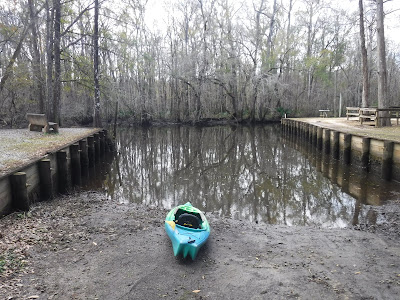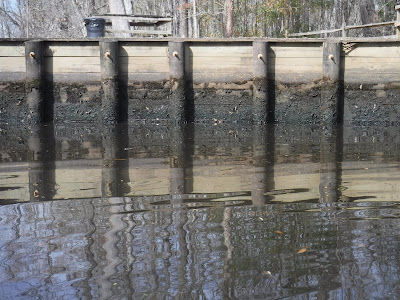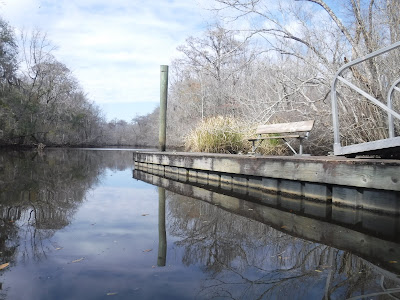When we arrived in the area, we searched around Savannah for things to do. Tybee Island popped up immediately and at the top of the list. We wondered, "Why haven't we visited Tybee Island before?" We couldn't answer that question.
Our decision to visit Tybee Island today, Monday, January 31, 2022, which was the first nice day in several, was locked in when we visited the Forsyth Farmers Market in downtown Savannah on Saturday. One of the vendors was a couple who own Tybee Bakery with Cafe Miss Korea. Their kimchi was the most flavorful we have ever tasted, and it brought back memories of many Asian meals we have tasted where kimchi was served.
Tybee Island is the easternmost point in Georgia, yet the Port of Savannah, which is accessed on the Savannah River north of Tybee, is the westernmost U.S. seaport on the Atlantic Ocean. The island is the northeasternmost of Georgia's Sea Islands, which comprise the outer section of the state's Lower Coastal Plain region. Like the other Sea Islands, Tybee consists of a sandy beach on its eastern shore and a tidal salt marsh on its western shore. The interior consists of a maritime forest and freshwater sloughs. The Savannah River empties into the Atlantic Ocean just north of Tybee Island, placing the island in a historically strategic location.
In 1958, the Air Force accidentally dropped an atomic bomb near the island. Though the "Tybee Bomb" did not detonate (and, according to the Air Force, was not armed with a fuse), there has been ongoing concern, since the Mark 15 nuclear bomb lost during the mishap was never found. In more recent years, probes with radiation detection devices suggest that the bomb may be buried underwater near Little Tybee Island. We decided that the signs warning of a $1,000 fine for trying to wade across to Little Tybee Island might be based as much on the lost bomb as on the risk of drowning in unpredictable tides.
Despite the risk of death from atomization, this morning we headed out to Tybee Island:
Our first stop was the 19th Street Beach, where we could walk south along the beach across from Little Tybee Island, and then north to the Tybee Island Fishing Pier. As we walked out onto the beach, we were greeted with a cheerful, placid, uncrowded beach scene:
While a few humans walked along the water, there were more birds than humans:
It wasn't long before we spotted a sea kayak tour paddling along the shoreline. While the weather was comparatively warm for us landlubbers (maybe 55F), it was still chilly for the mariners. Little Tybee Island (and perhaps the atomic bomb) is in the background:
Not thinking much about the atomic bomb, Kathy found a comfy swing and sat, swinging, contemplating the rhythmic beauty of a day at the beach:
We worked our way back north along the beach, past 19th Street, toward the fishing pier, which we saw beyond a nearby rock jetty:
A sign warned (again, under penalty of hefty fine) not to walk on the rocks, this grackle apparently didn't get the memo:
It was receding tide, and we walked along the high water line looking for unbroken shells and other detritus. We found a few precious and curious items, including this fresh jellyfish still sparkling in the sunlight.
Reaching the pier, we walked out on it to watch the people fishing in the near waters of the Atlantic Ocean. As we stood at the end of a pier, a convoy of four pelicans flew toward us from the north. One of them peeled off and dove to the water's surface, presumably to catch a fish. The other three continued past us toward the south, and this member of the trio waved his wings at us as s/he passed:
While rocks and broken shells were the dominant finds of the day, we did find one delicate starfish, who was missing only the part of one arm:
By the time we got back to the Jeep, we found that we had used the entire morning for our beach walk, so we headed back to Cafe Miss Korea to see if we could get some Korean Barbeque. Unfortunately, the cafe was closed, and we had to search for an alternative. Even though there were few restaurants open on the beach at this time of year, we found the nearby
Salt Island Fish and Beer, which serves modern beach food from locally sourced ingredients.
Each of us found a beer we liked, and then we went our separate ways for food. While David feasted on a Mahi Bhan Mi, Kathy went for raw oysters and fish tacos. She didn't seem to regret her choice:
After meeting an engaging miniature Australian sheepdog named, "Tumbler," (and his mom) on the deck of the restaurant, we headed out to our next stop -- the Tybee Island Light:

Tybee Island's strategic position near the mouth of the Savannah River has made the island's northern tip the ideal location for a lighthouse since Georgia's early settlement period. First built in 1736, the lighthouse was made of brick and wood, and stood 90 feet tall, making it the highest structure in America at that time. The original lighthouse has been replaced several times. The second lighthouse was built in 1742 when beach erosion threatened the first. Part of the third lighthouse at the site, built in 1773, still stands as the bottom 60 feet of the present lighthouse. The top 94 feet of the current lighthouse were added in 1867. Today, the Tybee Lighthouse is a popular tourist destination, having all of its support buildings on the 5-acre site historically preserved. The current black-and-white tower markings are a reversion to its fourth day mark, first used in 1916. The Tybee Island Light Station is one of just a handful of 18th-century lighthouses still in operation in North America, and is operated by the U.S. Coast Guard while the property is owned and managed otherwise by the Tybee Island Historical Society.
We can never resist lighthouses, and so we explored this one, too!
Up we went, 178 stair, to be precise, around and around inside the brick column:
Six landings along the way provided alcoves in the 12-foot thick walls where we could peer out paned windows across views of the island:

Being excited about the views up top, David raced ahead up the stairs. When he got to the top, he filmed this walk around the catwalk, looking in all four compass directions.
Once Kathy arrived on the catwalk, we looked down and around. The rest of the lighthouse station laid out below us. We remarked the beautifully restored buildings and the shadows of the trees below, which spread out away from the trees themselves, which were barely visible:
The lighthouse boasts a 1st Order Fresnel Lens. A Fresnel lens is a type of composite compact lens developed by the French physicist Augustin-Jean Fresnel (1788–1827) for use in lighthouses. It has been called "the invention that saved a million ships." The design allows the construction of lenses of large aperture and short focal length without the mass and volume of material that would be required by a lens of conventional design. A Fresnel lens can be made much thinner than a comparable conventional lens, in some cases taking the form of a flat sheet. Fresnel lenses come in six classes, with 1st class being the largest and being capable of shining the furthest, and 6th class being the smallest with shortest effective range. Of 79 active lighthouses in the U.S. having Fresnel lenses, 10, including the Tybee Island Light, have the largest 1st Class lenses.

We still hadn't finished absorbing all of this technical information when we arrived at
Fort Pulaski National Monument. It is one of a series of coastal forts constructed by order of President James Madison after the War of 1812. During the Civil War, it was held by Confederate forces. U.S. forces established batteries of rifled cannon across the water on Tybee Island and demonstrated the effectiveness of that technology in demolishing these traditional brick forts, thus rendering Fort Pulaski and all other "Third System" forts like it (such as Fort Jefferson, in the Dry Tortugas), effectively obsolete. After Confederate forces surrendered the fort, U.S. military supervised this and other other 1812 forts until the early 20th Century, when they were abandoned.
We had a chance to walk around Fort Pulaski in late afternoon, when the low angle of the light showed off the lines and features of its structure. The moat has been preserved and restored, making us ponder the fact that forts with moats and drawbridges were features of defensive warfare for hundreds of years, from the Middle Ages through the 1800's:
Earthen mounds were constructed outside the fort to protect powder magazines from bombardment:
The southeastern walls of the fort took the major beating from Union batteries of rifled cannon, and the damage is apparent to a visitor walking around that side of the fort:
The inside boasts parade grounds and barracks similar to those of other forts from the same period, such as Fort Sumter, the fort in St. Augustine, Fort Jefferson off Key West, and others we have seen. We felt, however, that Fort Pulaski has been the best preserved and rebuilt:
As we left the fort, we looked at our watches and realized that we had run out of time. We had used our whole day on Tybee Island, and hadn't left enough time to hike out to that cute little Cockspur Island Lighthouse, sitting just off Cocksput Island where Fort Pulaski is located, and which boasts a little 6th Order Fresnel Lens. Here is a photo we downloaded (Source: By Jud McCranie - Own work, CC BY-SA 4.0, https://commons.wikimedia.org/w/index.php?curid=74450533):
The Cockspur Island Light is the smallest lighthouse in Georgia. It was built from 1837-1839 as a daymarker without lights to indicate the entrance to the South Channel of the Savannah River. It ceased operation as an active beacon in 1909, but has been relit since 2007 for historical rather than navigational purposes.
Wait! We forgot to mention that we found some pretty shells on the Tybee Island beach! These are the prettiest and most complete ones we found:
So, all in all, this was a pretty huge day. We think we explored most of the most interesting features of Tybee Island and we hope this interests you in exploring it further yourself.




















































